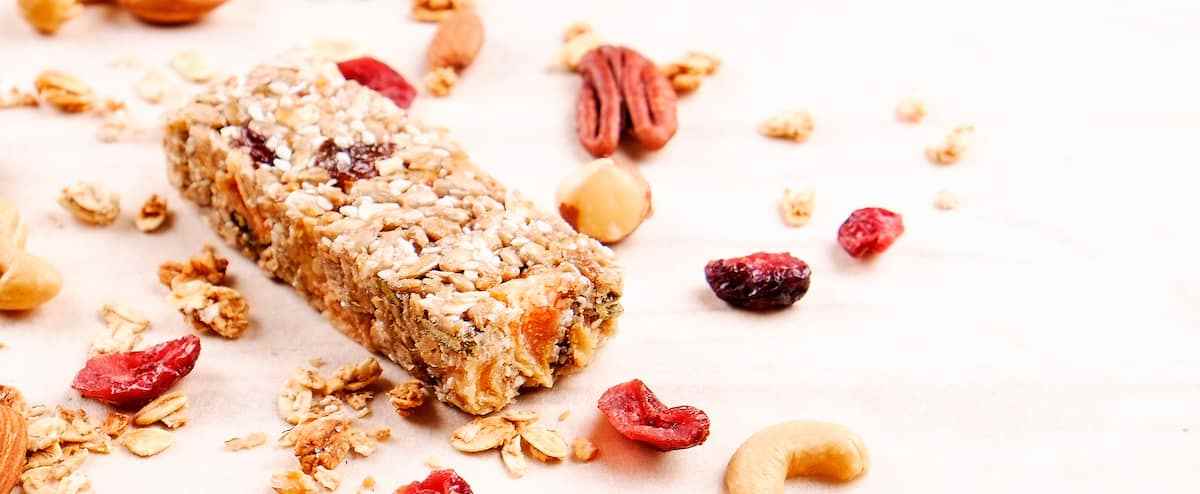Sports bars are more popular than ever. Available in grocery stores as well as gyms and sports stores, they come in several versions. Practical, they slip perfectly into the sports bag and they have a long lifespan. What are the best choices? Our analysis !
Sports bars can be divided into two categories: energy bars and protein bars. Energy bars are higher in carbohydrates and are suitable before exercise.
Protein bars are ideal after exercise and they generally combine a good carbohydrate-protein ratio.
This week, the bars that fit before exercise are the subject of this article. For the choice of an energy bar, we look for:
- A short ingredient list with natural ingredients;
- A carbohydrate content of at least 20g per serving;
- A protein content of less than 10g per serving;
- A fat content of less than 8g per serving.
A short list of ingredients is to be favored in order to avoid the presence of superfluous ingredients.
These are most often food additives, artificial colors and flavors as well as low-calorie sugars such as sweeteners and sugar alcohols (sorbitol, mannitol, etc.).
Even if the use of these ingredients is authorized by Health Canada, sugar alcohols can cause digestive discomfort in some people (stomach aches, gas, bloating, diarrhea) when consumed frequently and in large quantities.
Carbohydrates are the most efficiently metabolized source of energy by our body, compared to proteins and lipids.
Therefore, before physical exertion, a high carbohydrate intake is recommended in order to be able to maintain a good level of intensity.
Among the types of carbohydrates, simple sugars (such as fructose, a natural sugar in fruit) should be favored one hour before physical activity, because they are absorbed more quickly than complex sugars (such as starch).
In the case of the energy bar, it is preferable to minimize the fiber content since they slow down digestion and can even cause digestive discomfort.
The same logic applies when it comes to protein and fat content, as these two nutrients also have the effect of slowing our digestion, which is not ideal when looking for a boost fast energy.
This week, we review the bars that are suitable before physical activity.
Focus on the best choices!
5 good choices of energy bars (before physical exertion)
Chronobar – Energy bar (Cherry and chocolate)
Kronobar, now Krono Nutrition, is a Quebec company that offers a wide range of products designed for athletes, including energy bars, protein bars, energy gels, etc. These include this cherry and chocolate energy bar made with 100% natural ingredients, including: cherries, unsweetened chocolate, date syrup, flour and oatmeal, pumpkin seeds, cocoa and sunflower oil.
This short list of ingredients is certainly appreciated and for a 50 g bar, we get 180 calories, 32 g of carbohydrates (including 15 g of sugars), 4 g of protein, and 6 g of fat (of which 2.5 g saturated fat). It is gluten-free, vegan and devoid of the 12 main allergens.
Scratch Labs – Energy bar (Chocolate and almond)
Scrath Labs was founded by Dr. Allen Lim, a sports physiologist and consultant to many Olympic-level cycling teams. Thus, the products of this company are made from natural ingredients (from scratch) in addition to being vegan and gluten-free.
When analyzing the ingredient list of the chocolate and almond energy bar, we note the presence of natural sources of proteins and lipids, including nut butter as well as whole grains, including oats, rice brown, quinoa and sorghum.
As for carbohydrate intake, it comes mainly from tapioca syrup, coconut nectar, semi-sweet chocolate chips, but also dried cranberries. Small problem, the bar is also composed of glycerin and sunflower lecithin (emulsifying agent).
So, for a 50 g bar, we get 200 calories, 30 g of carbohydrates (and only 7 g of sugars), 4 g of protein and 8 g of fat (including 2 g of saturated fat).
Naak – Energy bar (Berries and nuts)
The Quebec company Näak has distinguished itself in the sports nutrition market by incorporating crickets in its products as a source of protein.
However, when it comes to its energy bars, they are more vegan and made with a blend of proteins derived from peas, soy, sesame seeds and almonds.
Thus, for a 50 g serving, the berry and nut energy bar provides 200 calories, 28 g of carbohydrates (including 14 g of sugars), 7 g of protein and 8 g of fat (including 2.5 g of saturated fat). ).
Nature’s Bakery – Soft fig bar (Blueberries)
Nature’s Bakery Chewy Fig Bars are not sold as energy bars, but were selected because their nutritional profile is distinctly appealing.
Indeed, for a portion of 57 g, we obtain 200 cal, 38 g of carbohydrates (including 19 g of sugars), 3 g of protein and only 5 g of lipids (and no saturated fat).
It presents a short list of ingredients, in which we find whole grains, including whole wheat flour and oats, as well as natural sources of sugars, including fig paste. Too bad it contains glycerin, a sugar alcohol used in the industry to improve the texture of the bars.
Larabar – Tender bar (carrot cake)
Lärabar granola bars are distinguished by their list of ingredients which is not only short, but also made up of common foods that are easily found in our pantry such as dates, almonds, raisins, walnuts, unsweetened coconut, carrots, etc.
Thus, for a 45 g serving, a bar provides 190 calories, 26 g of carbohydrates (including 19 g of sugars), 3 g of protein and 8 g of fat (including 1.5 g of saturated fat).
All of the company’s products are vegan and certified gluten-free.
Next week, protein bars come under our scrutiny.
Thanks to Yasmine Jemaa, nutrition intern, for her precious collaboration
►Discover my recipe for energy balls, perfect before exercise www.isabellehuot.com/blogs/recettes-et-conseils/boules-denergie.





